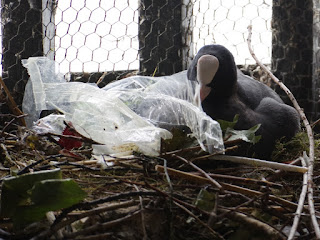The Coots nesting in a dangerously exposed place near the bridge lost their first brood, but now they have hatched another three chicks. There was still one egg not so far hatched. The mother was having a hard time getting all the chicks arranged in a comfortable position.
Fran managed to get a picture of the Great Crested Grebe family on the Serpentine with all three chicks visible.
The family on the Long Water also have three.
And the young grebe prematurely thrown out by the Serpentine pair brings the total to seven. It was investigating a net around a reed bed for insects, which grebes happily eat as a change from aquatic creatures.
The Coots nesting in the boathouse have decorated their nest with a plastic bag.
A cygnet was flapping its tiny wings. Mute Swans don't develop their wings until they are more or less full size. This actually increases their chances of survival, as swans are not manoeuvrable in the air and are liable to crash into obstacles and injure or kill themselves.
There are a few Canada Geese with white-speckled heads among the hundreds that have come to moult on the Serpentine, and this is the most specked one. It is a pure-bred Canada, I think, not a hybrid.
There was a large mixed group of Common and Red-Crested Pochards on the gravel bank in the Long Water. This is only about a third of them, plus one Mallard and one Tufted Duck.
The Mandarin family with two young was on the near side of the lake. The mother shooed some Feral Pigeons away from her offspring.
One of the two very dark Mallard drakes was here as well. He is in full eclipse and just regrowing his wings, but doesn't look much different from usual -- unlike the normal Mallard drakes, which are looking very drab and brown.
The Blue Tits, which were also moulting and looking quite tatty, and recovering and regrowing their smart blue head feathers.
The female Little Owl at the leaf yard looked round from her perch.
The Little Owls nesting at the top of Buck Hill above the Henry Moore sculpture have two owlets, which can be heard begging for food. But they remain invisible. I've spent some time trying to spot one. They are in three large horse chestnut trees between the entrance to the allotment and the entrance to the park offices.
Four rabbits were visible under the sculpture, and two of them were young. So the population really is recovering, much later than usual this year.
Just along the path, a Red Admiral butterfly perched on a nettle.













Fran's picture of the Grebes' family is so very lovely, it could serve perfectly as a postcard for the park.
ReplyDeleteThat white-speckled Canada goose looks as if it had poured white flour on itself. Is it the same thing that occurrs in white-patched Blackbirds?
No Black Swan today - hope he isn't feeling too lonely all by himself. He looks like an affectionate and I think gregarious bird.
Various species of birds seem to get white speckles or patches. It's one of the many manifestations of leucism -- a defect in the colour-producing mechanism.
DeleteI didn't see the Black Swan today. But he's easy to miss when surrounded by a crowd of Mute Swans, so it's too early to guess that he's left.
Is the plastic bag a suffocation risk for the birds, maybe?
ReplyDeleteNot for Coots or Great Crested Grebes. They find plastic bags very useful for strengthening their nests, and handle the material with assurance.
DeleteVery enjoyable film of the restive coot chicks!
ReplyDeleteThey were being unusually awkward today. Hope we see a fourth one tomorrow.
DeleteThe black swan was in the middle of the Serpentine near the island around 9.30 this morning.
ReplyDeleteExcellent. Thanks.
DeleteReally like your photo of the cygnet. This morning a young jay swooped down to gently take a shelled peanut from the palm of my hand!
ReplyDeleteIn this park? There's one in St James's Park that will eat off your hand if it knows you. In my experience the Jays here will do a flying grab but won't stay.
Delete